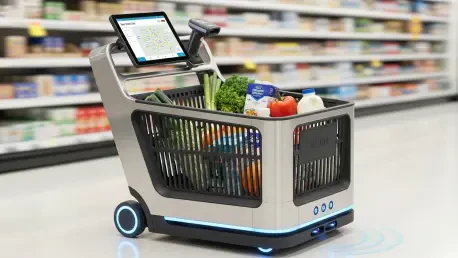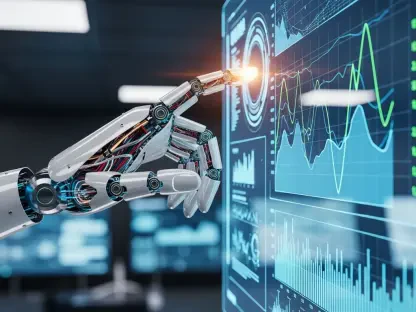Imagine walking into a grocery store, grabbing a cart that not only holds your items but also tracks your budget in real time, suggests personalized deals based on your location in the store, and seamlessly connects your in-store purchases to online orders. This is no longer a distant vision but a reality with Instacart’s innovative Caper Carts. These smart carts are transforming the grocery shopping experience by bridging the gap between physical and digital retail spaces. This guide aims to help readers understand how to leverage these cutting-edge tools to enhance their shopping efficiency, save money, and embrace an omnichannel approach that blends the best of both worlds. The purpose of this resource is to provide a clear, step-by-step explanation of the features and benefits of Caper Carts for shoppers, retailers, and business stakeholders looking to stay ahead in the evolving retail landscape.
The importance of adopting smart technology in grocery shopping cannot be overstated in an era where convenience and personalization are paramount. With economic pressures mounting, consumers are seeking ways to manage budgets while expecting tailored experiences that save time and effort. For retailers, the challenge lies in meeting these demands while driving revenue and fostering customer loyalty. This guide offers a comprehensive look at how Instacart’s upgraded Caper Carts address these needs, providing practical insights into their features and broader implications. By exploring this technology, readers can gain a competitive edge, whether they are everyday shoppers or industry professionals aiming to integrate digital solutions into their strategies.
Revolutionizing Grocery Shopping with Smart Technology
Grocery shopping has long been a routine task, often marred by long checkout lines and the struggle to keep track of spending. Instacart’s Caper Carts are changing this narrative by introducing a tech-driven solution that redefines convenience. These carts come equipped with interactive screens and advanced software, allowing shoppers to scan items, view running totals, and access digital coupons as they move through the aisles. This transformation is not just about skipping lines; it’s about creating a fluid connection between in-store and online shopping experiences that cater to modern consumer needs.
Beyond individual benefits, Caper Carts are proving to be a game-changer for retailers aiming to boost engagement and revenue. By integrating features that encourage omnichannel behaviors—such as prompting online reorders after in-store purchases—these carts help stores capture a wider customer base. The technology also opens new avenues for targeted advertising and data collection, offering valuable insights into shopping patterns. This dual advantage positions the carts as a vital tool in the digital evolution of retail spaces.
This guide will delve into the specific upgrades Instacart has implemented, from real-time budget tracking to AI-powered innovations. Each enhancement is designed to address common pain points while paving the way for a more intuitive and rewarding shopping journey. Readers will discover actionable ways to utilize these features, whether for personal savings or business growth, and understand why embracing such technology is essential in today’s competitive market.
The Evolution of Smart Carts in Grocery Retail
Smart cart technology has emerged as a significant trend in the grocery industry over recent years, reflecting a broader shift toward digitization in physical retail environments. Initially developed to streamline checkout processes, these carts have evolved into sophisticated platforms that enhance customer interaction and store efficiency. Instacart’s journey with Caper Carts exemplifies this progression, starting with a focus on skipping lines and expanding into a comprehensive tool for engagement and data-driven personalization.
The significance of this evolution lies in its impact on both consumers and retailers. Shoppers benefit from a more controlled and interactive experience, while stores gain access to real-time behavioral data that informs inventory and marketing decisions. Instacart has positioned Caper Carts as a bridge to omnichannel shopping, encouraging users to blend in-store purchases with online orders. This adaptability is crucial as consumer expectations continue to prioritize seamless integration across shopping channels.
In a competitive landscape, Instacart is not alone in pursuing smart cart innovations. Other players, such as Amazon with its own cart technology and Veeve with retrofit solutions, are also investing in this space, underscoring the growing importance of digital tools in grocery retail. This rivalry drives continuous improvement, ensuring that technologies like Caper Carts remain at the forefront of meeting modern demands. Understanding this context helps highlight why adopting such solutions is a strategic move for staying relevant in a rapidly changing industry.
Key Upgrades to Instacart’s Caper Carts
Instacart has rolled out several enhancements to Caper Carts, each designed to create a seamless omnichannel shopping experience that benefits both consumers and retailers. These upgrades incorporate advanced technology, user-centric design, and strategic integrations with retailer systems. Below, detailed explanations of each feature provide a roadmap for maximizing their potential.
The focus on omnichannel integration is evident in how these carts connect physical shopping with digital platforms. From personalized offers to practical usability tweaks, every update aims to address specific challenges while enhancing engagement. Readers can follow these insights to understand how each improvement contributes to a more efficient and enjoyable shopping process.
Feature 1: Real-Time Budget Tracking and Coupon Clipping
One of the standout features of the upgraded Caper Carts is the ability to track spending in real time and access digital coupons directly on the cart’s interactive screen. As items are scanned and added, the display updates the total cost instantly, giving shoppers complete visibility over their budget. This functionality, paired with the option to clip coupons on the go, ensures that savings are just a tap away, making the shopping experience both cost-effective and engaging.
Enhancing Financial Transparency
This real-time tally addresses a critical consumer need for transparency, especially during times of economic strain. With inflation impacting purchasing power, knowing the exact cost of a cart’s contents influences decisions at the point of sale, helping avoid overspending. Shoppers can adjust their selections on the fly, ensuring they stay within financial limits. This feature not only builds trust but also encourages more mindful buying habits, aligning with current consumer priorities for control and clarity.
Feature 2: Location-Based Personalization with NVIDIA Software
Another significant upgrade involves the integration of NVIDIA Jetson software, which powers personalized product recommendations and location-based coupons. As shoppers navigate the store, the cart’s system identifies their position and suggests relevant items or deals based on nearby products, past purchases, and current cart contents. This tailored approach transforms a routine task into a customized experience that feels intuitive and helpful.
Tailoring Offers to Shopper Location
The ability to deliver aisle-aware advertising and nearby deal alerts enhances the relevance of promotions, increasing the likelihood of in-store purchases. For instance, a shopper near the dairy section might receive a coupon for yogurt, directly influencing their decision to add it to the cart. This precision in targeting not only boosts sales for retailers but also adds value for consumers by highlighting savings opportunities they might otherwise miss, creating a win-win dynamic in the shopping journey.
Feature 3: Practical Design Updates for Usability
Instacart has also focused on physical enhancements to improve the usability of Caper Carts. Updates include a lower tray for accommodating bulky items like cases of water or large pet food bags, reducing the struggle of fitting oversized products. Additionally, shoppers can mark personal belongings, such as handbags, on the system to prevent confusion during checkout, ensuring a smoother and less stressful process.
Simplifying the Shopping Journey
These design changes tackle common frustrations that disrupt the shopping flow, such as juggling heavy items or worrying about misplaced personal effects. By addressing these practical concerns, the carts become more user-friendly, allowing shoppers to focus on their selections rather than logistical hassles. This attention to detail in design significantly improves the overall experience, making the technology accessible to a broader range of users with varying needs.
Feature 4: Future-Ready Innovations with AI and Wayfinding
Looking ahead, Instacart is developing cutting-edge features like AI-driven shelf scanning and wayfinding capabilities using Carrot Tags, which are electronic shelf labels. These innovations aim to make store navigation effortless by guiding shoppers to specific items with flashing indicators. Combined with AI analysis of video data from side-facing cameras, these tools promise to deepen the integration of technology into everyday shopping tasks.
Navigating Stores with Gamified Incentives
The potential for gamification tied to wayfinding introduces an engaging element, where shoppers might receive rewards or incentives based on their location in the store. This approach transforms navigation into a rewarding activity, encouraging exploration of different aisles while simplifying the search for specific products. Such forward-thinking features signal a future where shopping is not just functional but also an interactive and enjoyable experience, setting a new standard for retail engagement.
Summary of Caper Cart Enhancements
The upgrades to Instacart’s Caper Carts offer a robust set of tools that elevate the omnichannel shopping experience. Here is a concise recap of the major enhancements for quick reference:
- Real-time budget tracking and coupon clipping for better financial control.
- NVIDIA-powered personalization with location-based offers for tailored shopping.
- Practical design tweaks, such as lower trays, for improved user convenience.
- Forward-looking features like AI scanning and gamified wayfinding for future-ready innovation.
These points collectively underscore the goal of creating a seamless blend of in-store and online shopping. By integrating advanced technology with practical solutions, Caper Carts cater to diverse needs, ensuring that both consumers and retailers benefit from enhanced efficiency and engagement. This summary serves as a snapshot of the transformative potential embedded in each update.
Broader Implications for Retail and Consumer Trends
The deployment of Caper Carts aligns with significant industry trends, particularly the push for digitization and personalized shopping experiences. As grocery retail continues to evolve, smart technology becomes a cornerstone for meeting consumer expectations of convenience and relevance. These carts represent a shift toward integrating digital interfaces into physical spaces, allowing retailers to offer experiences that rival the customization of online platforms while maintaining the tactile appeal of in-store shopping.
For retailers, the implications extend to strategic planning and revenue generation. The interactive screens on Caper Carts serve as a powerful medium for retail media, enabling targeted advertising that drives additional income. Consumer packaged goods companies also gain from this setup, as aisle-specific promotions enhance product visibility and competitiveness. Data collected from logged-in users further enriches retailer insights, informing inventory decisions and marketing campaigns with precision that was previously unattainable in traditional settings.
Despite the promise, challenges such as high implementation costs and scalability remain. Adoption is currently limited to select markets, and the expense of rolling out smart carts across widespread locations poses a barrier. However, engagement metrics, including high redemption rates for omnichannel offers, suggest a positive outlook. Over the next few years, from 2025 to 2027, continued investment and innovation could address these hurdles, positioning smart carts as a standard feature in grocery retail while reshaping how consumers interact with stores amid economic pressures.
Embracing the Future of Grocery Shopping
Reflecting on the journey through Instacart’s Caper Cart enhancements, it is evident that these tools have redefined grocery shopping by merging convenience with cutting-edge technology. Each feature, from budget tracking to AI-driven navigation, has played a pivotal role in addressing consumer needs while empowering retailers with new revenue streams and data insights. The exploration of these upgrades has highlighted a transformative shift in retail, where physical and digital experiences become seamlessly intertwined.
Looking ahead, the next steps involve staying attuned to advancements in smart cart technology and considering practical applications for individual or business use. Retailers and stakeholders can explore partnerships to integrate such solutions into their operations, gaining a competitive edge in a crowded market. For consumers, experimenting with these carts during shopping trips offers a chance to experience firsthand the benefits of personalized deals and streamlined processes. Keeping an eye on industry developments over the coming years promises to reveal even more innovative ways to enhance the grocery shopping landscape.









